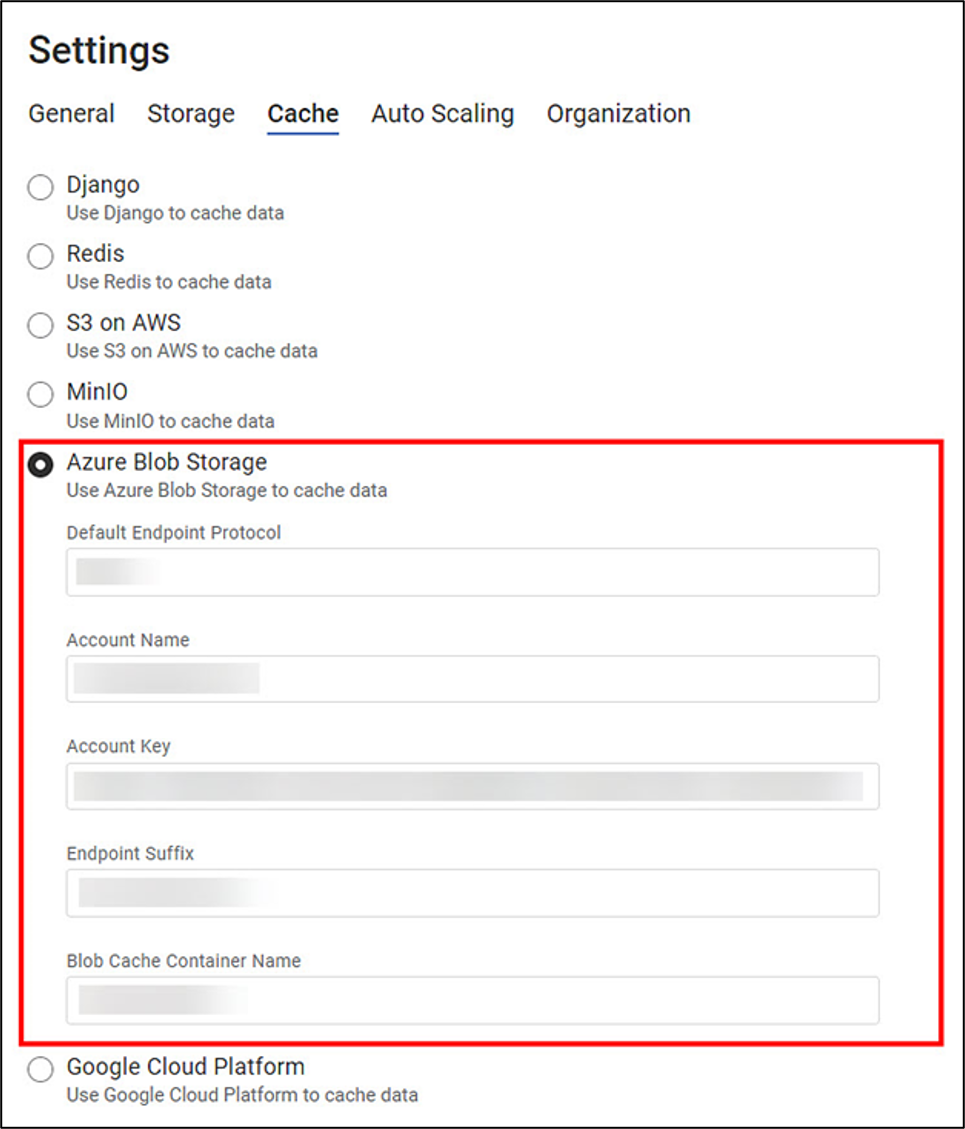Cache
In Rubiscape, the cache settings are at the instance level. Currently, Rubiscape supports six types of caches. You can select any caching method as required.
| Note |
|
- Django
- Redis
- S3 on AWS
- MinIO
- Azure Blob Storage
- Google Cloud Platform
The following sections explain these storage types in detail.
Django
Django is the default storage for Rubiscape cache.
It requires no additional inputs.
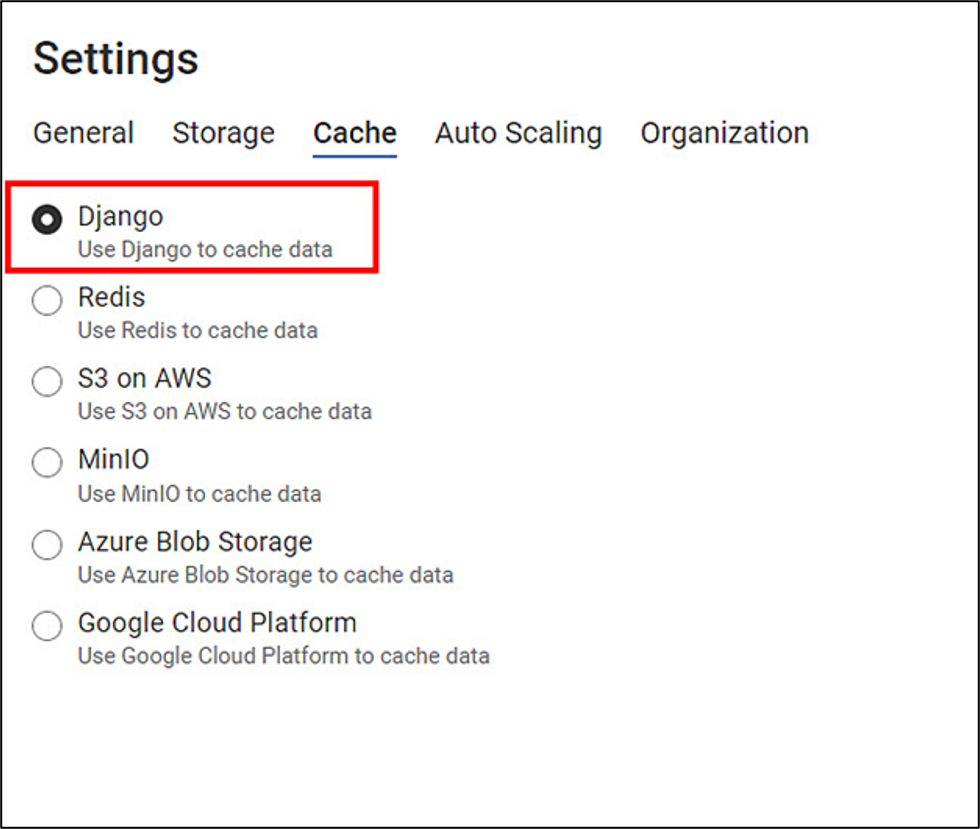
Redis
Redis is an open-source in-memory data structure store used as a cache in Rubiscape.
The Redis cache contains the following fields.
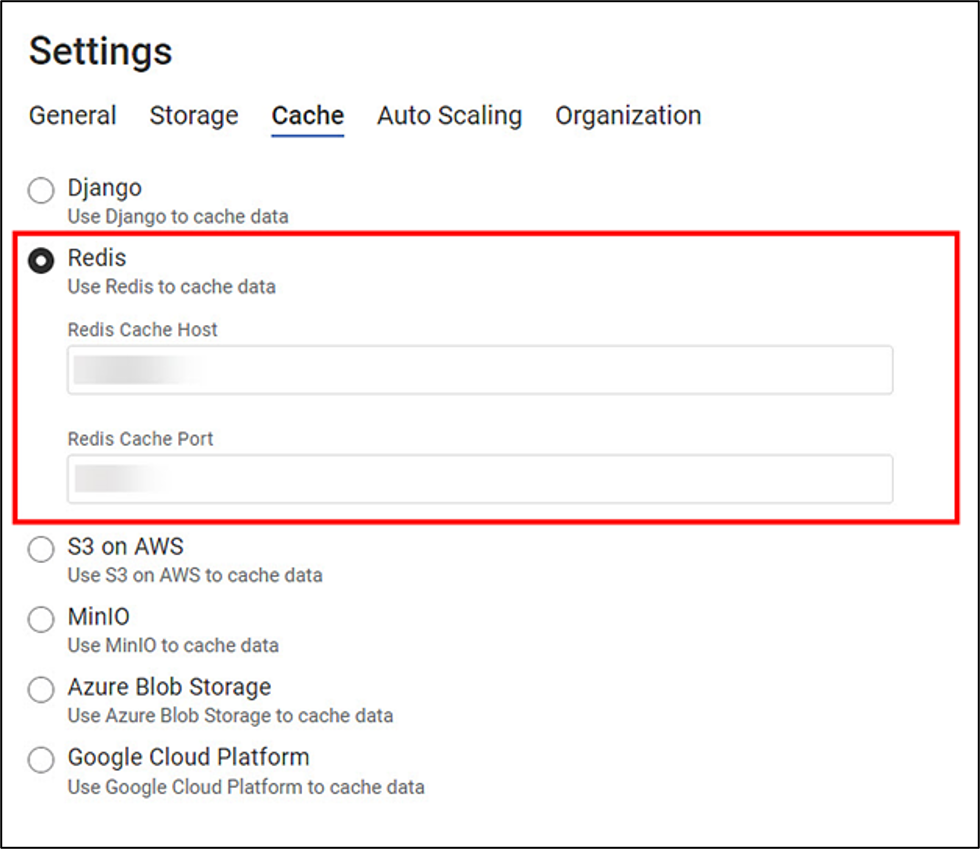
The following table explains various fields in Redis cache settings.
Field | Description | Remark |
|---|---|---|
Redis Cache Host | Enter the cache host on which the Redis cache is stored. | Usually, the cache is stored on the localhost. |
Redis Cache Port | Enter the cache port to which the Redis cache is connected. | The default Redis cache port is 6379. |
S3 on AWS
Amazon Simple Storage Service (S3) is a public cloud object storage service that stores data as objects within buckets. The object is a combination of a file and its metadata. Buckets are containers to store these objects.
The S3 on the AWS cache contains the following fields.
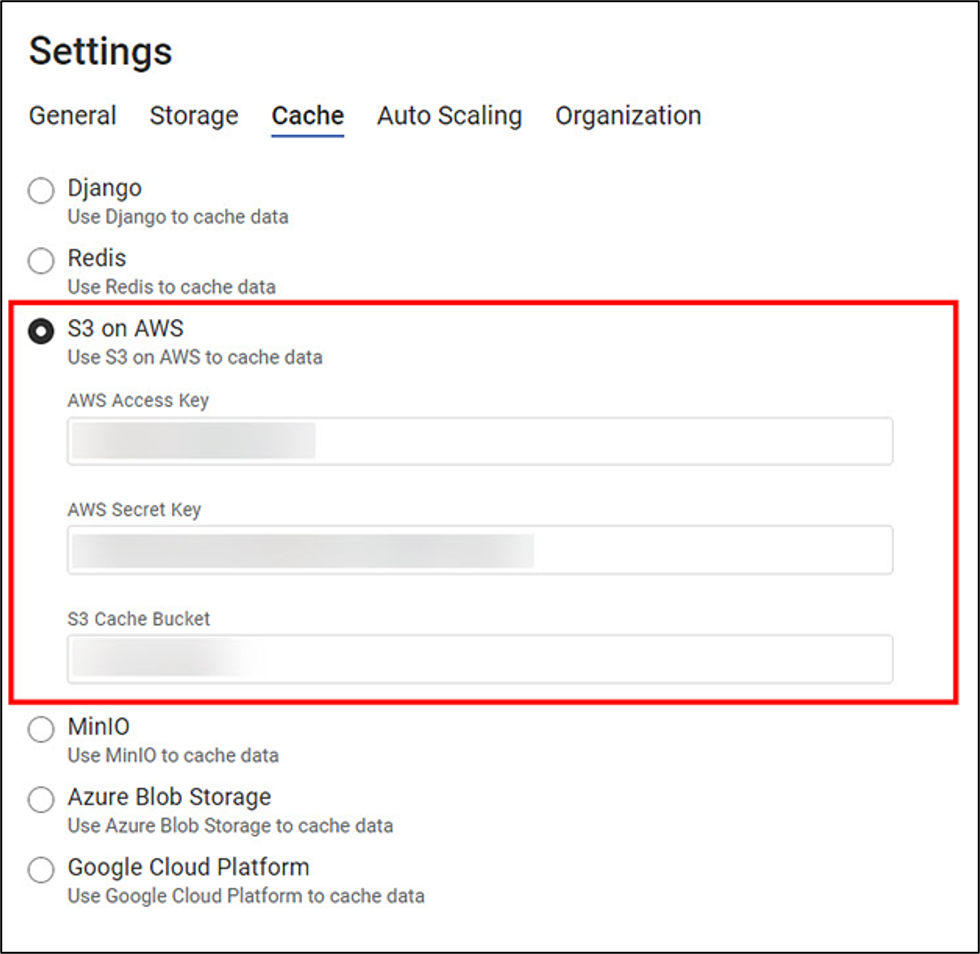
The following table explains various fields in S3 on AWS settings.
Field | Description | Remark |
|---|---|---|
AWS Access Key | Enter the AWS Identity and Access Management (IAM) Key. |
|
AWS Secret Key | Enter the secret key to sign requests. |
|
S3 Cache Bucket | Enter a suitable name for the S3 cache container. |
|
MinIO
MinIO is an open-source distributed object storage server. It comes with an S3 storage functionality designed for private cloud infrastructure. MinIO is one of the best servers for storing unstructured data (images, videos, log files, backups, and containers).
The MinIO cache contains the following fields.
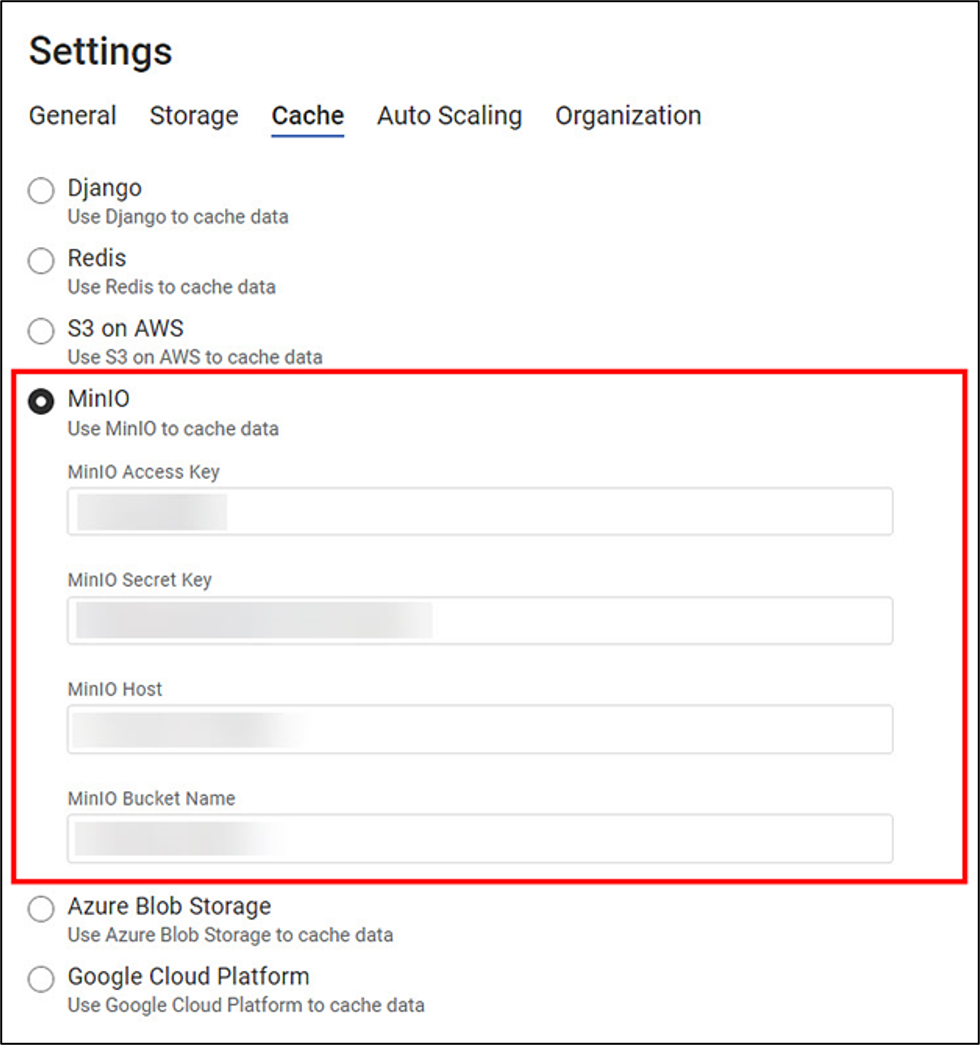
The following table explains various fields in MinIO settings.
Field | Description | Remark |
|---|---|---|
MinIO Access Key | Enter the MinIO Access Key to authenticate the user. |
|
MinIO Secret Key | Enter the MinIO Secret Key to authenticate the user. | It is a unique key and equivalent to a password. |
MinIO Host | Enter a valid IP address to connect to the MinIO host server. | The hostname needs to include the port. |
MinIO Bucket Name | Enter a valid MinIO bucket name |
|
Azure Blob Storage
Azure Blob (Binary Large Object) Storage is Microsoft's cloud-based object storage solution. It is an optimized storage facility to store a huge amount of unstructured, text, and binary data.
The Azure Blob cache contains the following fields.
The following table explains various fields in Azure Blob cache settings.
Field | Description | Remark |
|---|---|---|
Default Endpoint Protocol | Enter the default endpoint protocol HTTPS, which is the default for Azure. |
|
Account Name | Enter the account name for the Azure cache. | It is user-specific. |
Account Key | Enter the account key for the Azure cache. | It is user-specific. |
Endpoint Suffix | Enter the endpoint suffix for the Axure cache. | The default endpoint suffix is core. |
Blob Cache Container Name | Enter a suitable blob cache name for the Azure cache bucket. | – |
Google Cloud Platform
Google Cloud Platform provides an object storage facility to companies of all sizes and data generation capacity. You can store and retrieve data as and when you want.
The Google Cloud Platform contains the following fields.
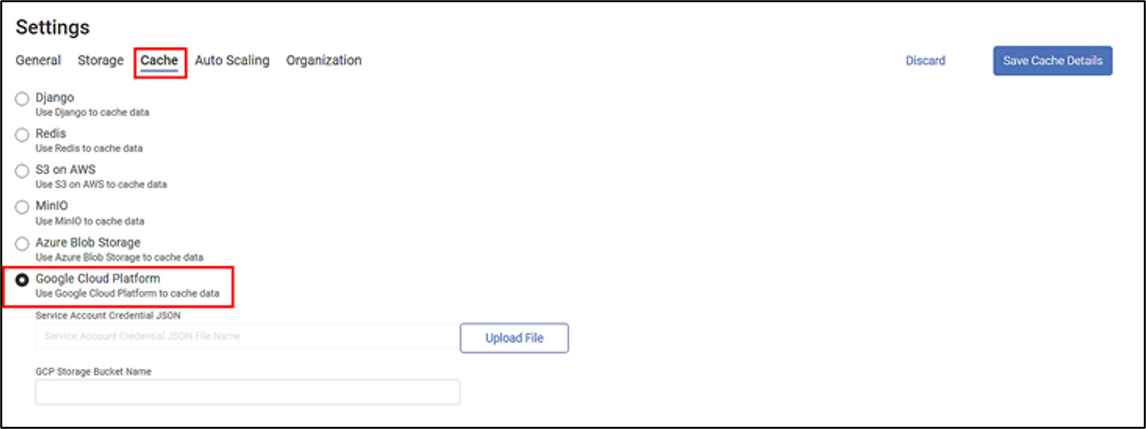
The following table explains various fields in Azure Blob Cache settings.
Field | Description |
|---|---|
Service Account Credential JSON | Click Upload File to upload the JSON file containing the service account credentials. |
GCP Storage Bucket Name | Enter a suitable name for the Google Cloud Platform cache container name. |
|
|
Related Articles
Refresh Cache
To enable auto-refreshing of the dashboard by scheduling workflow, follow the steps given below. On the home page, click the Create icon (). Hover over the Data Integrator tile and click the Create Workflow button. Create Workflow page is displayed. ...Add Cache Calculated Column
Rubiscape allows you to create a Cache Calculated Column in the dashboard. It has similar functionality as the Calculated Column. While creating a Cache Calculated Column, a cache file is generated. After every update in the source file or calculated ...Refreshing Dashboard using Scheduled Workflow
The dashboards that you create are static, meaning the dashboard views do not change if the data they represent is changed. For this, you can use the refresh function provided by RubiSight. Refer to Refreshing a Dashboard. However, there can be ...Disable Direct Query
To Disable Direct Query in a dataset in the dashboard, follow the steps below. Open the dashboard in edit mode. Refer to Editing the Dashboard. The dashboard is displayed. In the Data Pane, click the ellipsis corresponding to the dataset, and then ...Node Categories
Using Control in Workbook and Workflow Rubiscape provides a combined node hierarchy called Control in Model Studio and Data Integrator. The functionalities present herein are used to perform various tasks on Workbook and Workflow. The sub-categories ...
